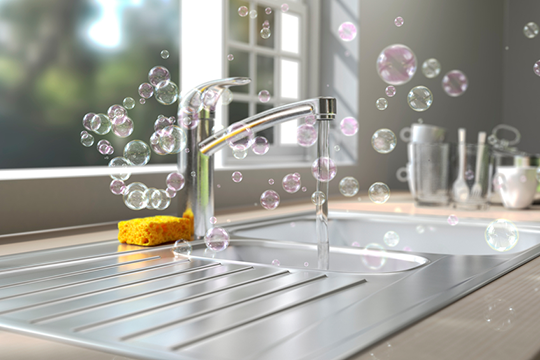
The Dirty Truth About Keeping Your Kitchen Sink Clean
By Sebrina Zerkus Smith | 4 Comments | Posted 06/06/2016
What is the dirtiest place in your home? I bet you said the toilet, didn’t you. But you’re wrong. The dirtiest place in your home is your kitchen sink. Keeping your kitchen sink clean is an important part of a healthy home.
It’s true. Your sink is brimming with all kinds of bacteria, just looking for an opportunity to make your family sick.
Think about what you put in that sink all day. Not just dirty dishes and souring milk, but bacteria from washing fruits and veggies, juice from raw poultry, paints from your kid’s craft project and gross slime from the dog’s water bowl. Ewwwww, right?!
Think I’m exaggerating? According to a 2008 study, 46% of kitchen sinks tested had a total bacteria count of more than 100,000 per square centimeter, that included E. coli, campylobacter, and salmonella. The average toilet seat? 50 bacteria per square inch, according to Dr Chuck Gerba, professor of microbiology at the University of Arizona.
The good news? You can learn how to keep your kitchen sink clean. It’s not hard. I’ll help you.
How To Keep Your Kitchen Sink Clean
- Make cleaning your sink a part of your regular cleaning routine. Every day. I repeat, every day.
- Keep your sink clean each day by adding a squirt of dishwashing liquid to a bowl of warm water. Dip a clean sponge, cloth or paper towel in the mixture and scrub the sink gently to remove food and stains. Rinse with running water. Discard the paper towel or sponge or immediately put the cloth in the laundry. Don’t use it to wipe your counter tops! If you do, your putting the bacteria you just washed off the sink onto your counter tops.
- Sanitize your sink 2 times per week by first drying the sink with a clean paper towel, then lining the sink with paper towels. Soak the paper towels with an anti-bacterial kitchen cleaning solution or make you own solution of 1 tablespoon bleach to 1 quart of water. Let the towels sit for 30 minutes, then discard them and rinse the sink with running water.
- Dry your sink with a paper towel after each use. Keeping your sink dry will help cut down on bacteria build-up. Bacteria breed better in a warm, wet environment.
- If you want to clean and sanitize, but avoid using bleach, check out this tutorial at apartment therapy.
- Cut down on bacteria by sanitizing your kitchen sponge. Rinse it throughly and then zap it in the microwave for 1 minute after each use. Allow to air dry before the next use. Or you can run your sponge through the dishwashing cycle. I find this convenient. I throw the sponge into the dishwasher with the rest of the dirty dishes and next morning —Boom! — clean sponge to start the day. Even doing this, change your sponge several times per week because sponges break down after a few times through the dishwasher. If you use a cloth to wash dishes, change it daily. Wash it in hot water and dry throughly.
- Remember to wipe the faucet, faucet handle and drain stopper down with anti-bacterial solution, too. Look for natural cleaning options without the chemicals!
So, now you know how to keep your kitchen sink clean. Your family, and everyone who comes into your kitchen from now on, thanks you.


 Contact us
Contact us




























4 Responses to The Dirty Truth About Keeping Your Kitchen Sink Clean